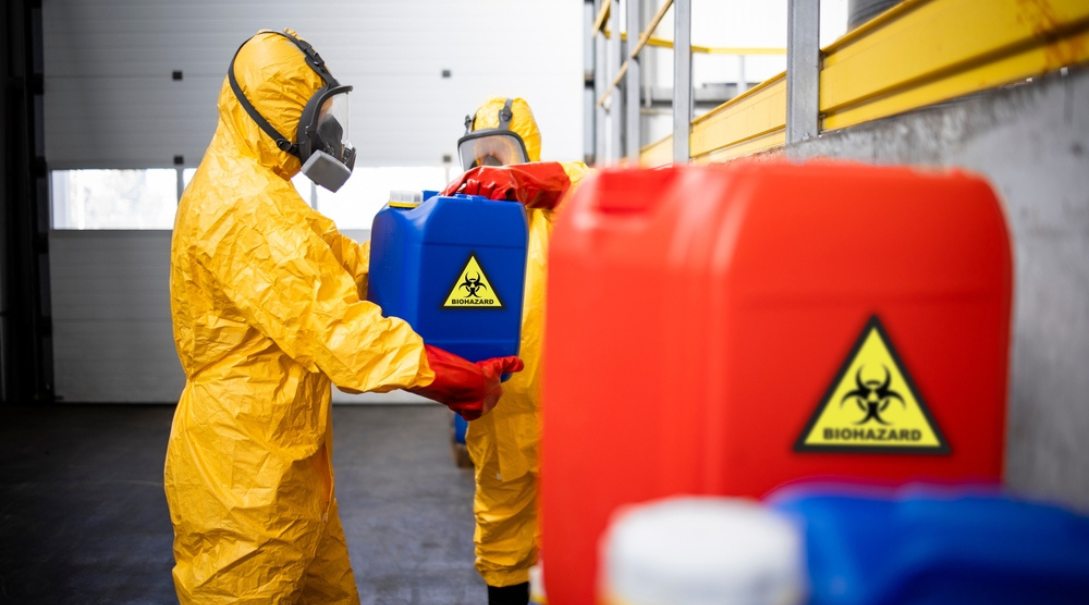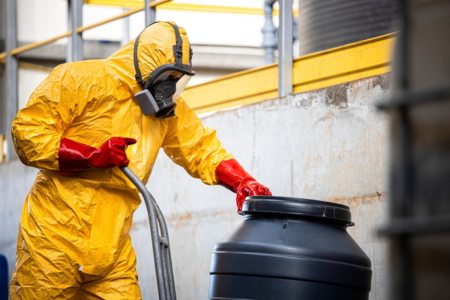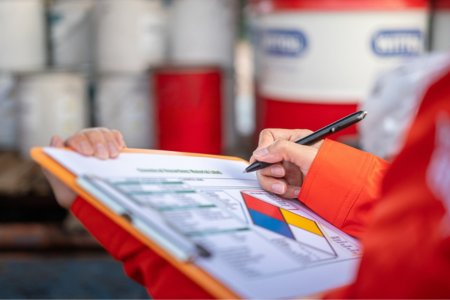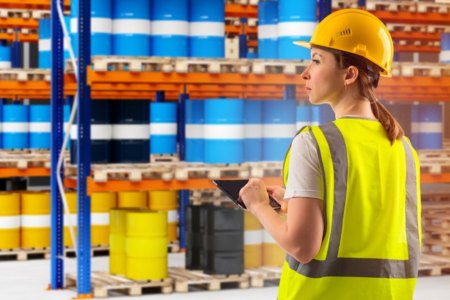TCLP (Toxicity Characteristic Leaching Procedure) is a test method used to determine the potential for hazardous waste to leach harmful chemicals into the ground, thereby affecting the groundwater.
It is an important tool for businesses and environmental professionals to identify hazardous waste and is key to waste management and environmental compliance.
In this guide, “What is TCLP?,” we will provide essential insights into navigating the complexities of hazardous waste regulations, ensuring business owners, managers, and environmental professionals have the information they need about TCLP’s role in safeguarding environmental and public health.
Table of Contents
The Importance of TCLP in Hazardous Waste Management
TCLP is a critical component of environmental protection efforts. It is a credible environmental hazard testing method that uses EPA testing protocols to prevent contamination of soil and groundwater.
When businesses, corporations, and manufacturers, among others, dispose of waste in the environment, such as in landfills, TCLP will verify whether certain measures need to be taken when handling particular substances.
Without appropriate testing, multiple potential consequences can occur, such as:
- Degradation of the environment
- Health risks to the public
- Non-compliance with environmental regulations
- Stiff penalties to businesses, corporations, manufacturers, etc.
- Significant fines to businesses, corporations, manufacturers, etc.
The TCLP hazardous waste identification method allows you to classify the waste as “hazardous” or “nonhazardous” for waste treatment and safe disposal.
Once there is clarity on “What is TCLP?” and why it is important, it is necessary to understand the process.
Understanding the TCLP Process
The TCLP process contains specific steps that must be followed to achieve accurate results. These include sample preparation, the extraction procedure, and the analysis of leachate for hazardous constituents.
Here is an overview of the step-by-step process of conducting a TCLP test:
- Liquid waste separation: Filter liquids (<.5 dry solid material) through glass fiber. This creates the TCLP extract. Separate and store wastes ( .5 or greater dry matter) for later analysis.
- Particle size reduction: Filter solid material using a 9.55mm sieve. Cut/crush/grind to a particle size of 1 cm or less to prepare for extraction.
- Solid material extraction: Place solid materials in a tumbler to simulate the leaching that occurs when water seeps through landfill waste. Extract solid materials (for at least 18 hours) utilizing a slightly acidic fluid equivalent to 20x its weight.
- Final separation: Separate liquid waste from solid waste utilizing a fiberglass filter. Discard solid materials and then assess liquid components (leachate). The initial liquid components from Step 1 may be analyzed separately or added to this liquid waste (depending on whether or not they are compatible).
- TCLP testing analysis: Identify and quantify all organic and inorganic materials utilizing methods approved by the EPA.
The EPA provides detailed information on each step to properly simulate the leaching process and identify potential hazardous contaminants.
Criteria for TCLP Hazardous Waste
TCLP tests for multiple contaminants, including toxic metals and certain organic compounds. To be classified as TCLP hazardous waste, the leachate must meet specific criteria, such as exceeding threshold concentration limits.
The following information outlines the criteria for TCLP hazardous waste.
Metals
TCLP tests for eight metals. Here is a list of the different metals and their TCLP limit for regulatory compliance. If the analysis (utilizing the calculations for 20x its weight) shows that the leachate meets or exceeds this limit, it will meet the criteria for TCLP hazardous waste.
Metal — Limit:
- Arsenic — 5.0
- Barium — 100
- Cadmium — 1.
- Chromium — 5.0
- Lead — 5.0
- Mercury — 0.2
- Selenium — 1.0
- Silver — 5.0
Organic Compounds
TCLP tests for many organic compounds, including volatile organic compounds, semi-volatile organic compounds, organochlorine pesticides, and chlorophenoxy acid herbicides.
A sampling of these compounds and their TCLP limits (mg/L) includes:
- Benzene — 0.5
- Chloroform — 6.0
- 1,2-Dichloroethane — 0.5
- Trichloroethylene — 0.5
- Vinyl Chloride — 0.2
- Hexachlorobenzene — 0.13
- Pentachlorophenol — 100.0
- Lindane — 0.4
- Toxaphene — 0.5
- 2,4-D — 10.0
- 2,4,5-TP (Silvex) — 1.0
The above list is not comprehensive. EPA Test Method 1311 contains a list of the breadth of organic compounds and metals tested for in the TCLP.
In summary, waste would be considered toxic/hazardous per Federal toxicity characteristics when analyzed via the TCLP method. It contains any metals or compounds in concentrations that equal or exceed the regulatory threshold (RT), i.e., their TCLP limits.
The Implications of TCLP for Businesses
When businesses have waste classified as hazardous under TCLP, owners and managers should be aware of several implications to manage the situation properly. These include regulatory, financial, and operational implications.
- Regulatory – Potential violations of regulatory guidelines across federal, state, and local jurisdictions.
- Financial – Potential high fines and/or cleanup costs that impact the bottom line and endanger business success.
- Operational – Potential slow-downs or interruptions (short or long term) in daily business operations.
In addition, if waste is improperly analyzed or disposed of, environmental degradation can occur, and public health may be at risk, which can harm the environment and people and put the business in legal jeopardy due to potential lawsuits.
Navigating TCLP Regulations: A Guide for Compliance
Businesses across industries must deftly navigate TCLP regulations to maintain compliance, which takes planning, strategy, and consistency. Certain actions are recommended for owners and managers of companies in commercial, manufacturing, logistics, hazardous waste, and other industries.
Here is an overview of processes and procedures that can be implemented to maintain compliance with TCLP regulations:
Enact best practices for waste management — tailor industrial waste management to your business with (1) weekly/monthly site assessments, (2) strategic waste consolidation, and (3) consistent tracking programs.
Customize and standardize waste treatment for your business — base treatment on form, composition, and quantity of waste; consider:
- Thermal treatment (incineration, gasification, and pyrolysis)
- Bioreactor landfills
- Biological waste treatment (composting or anaerobic digestion)
Conduct regular waste testing — plan and implement waste testing, including sampling and waste characterization/analysis.
These procedures are key to effective industrial waste management and are a foundation for your company’s ongoing environmental compliance.
Solutions for Managing TCLP Hazardous Waste**
Are you looking for solutions to manage TCLP hazardous waste?
The information below includes some available options for managing and reducing the generation of TCLP hazardous waste.
Waste minimization strategies — utilization of the following methods, customized to your needs. Consider:
- Source segregation or separation — usually low investment and easy implementation; a short-term solution.
- Process modification— potential savings in production costs, potentially reducing both hazard and volume; a moderate-term solution.
- End-product substitution — major investments required, large-volume hazard reduction; a relatively long-term solution.
- Material recovery and recycling— potential savings in manufacturing costs, reduced liability compared to commercial recovery; a moderate-term solution.
Utilizing one or more of the hazardous waste minimization methods is common, either simultaneously or sequentially.
Utilize waste treatment technologies — select as per form, composition, and quantity. Multiple technologies are available, including:
- Physical separation — options include gravity settling, filtration, flotation, flocculation, and centrifugation.
- Component separation — options include distillation, evaporation, ion exchange, ultrafiltration, reverse osmosis, electrolysis, carbon/resin absorption, and solvent extraction.
- Chemical transformation — options include precipitation, electrodialysis, chlorinolysis, reduction, chemical dechlorination, and thermal oxidation.
- Segregation technology (membrane segregation/separation)
- Biotechnology — conventional biological treatment methods include activated sludge, aerated lagoons, trickling filters, biocontactors, packed bed reactors, stabilization ponds, anaerobic digestion, land farming/spreading, and composting.
It is necessary to consider the management of TCLP hazardous waste with care and forethought. The complexities of hazardous waste management require in-depth knowledge, the proper resources, skills, and customized strategies for your business.
The Role of Environmental Professionals in TCLP Compliance
Environmental consultants and waste management professionals can assist businesses in understanding and complying with TCLP requirements. This includes various services to help companies control costs and minimize long-term liability.
Environmental professionals provide on-site services such as:
- Waste Characterization & Sampling
- Industrial Waste Management
- Waste Manifesting & Profiling
- Interim Measures & Site Remediation
- Equipment & Facility Decontamination
- Waste Minimization Planning
In addition, other helpful services for environmental compliance and safe working environments offered by consultants and professionals include:
- Compliance Audits
- Accident Prevention Plan Development
- Process Safety/Risk Management Planning
- Regulatory Planning & Reporting
These help with specific needs in TCLP compliance and provide solutions for an effective and safe industrial waste management program.
Frequently Asked Questions about TCLP
People often ask us, “What is TCLP?” because it is inherently complex.
Here are answers* to FAQs related to TCLP, including those addressing common misconceptions:
What is the time limit for filtering the TCLP leachates after completing the tumbling?
There is no specific time limit for the filtration of the leachate after tumbling. However, you should not delay. Start filtrations as soon as the tumbling is complete.
If we miss any of the holding times specified in the method or do not perform the procedure exactly as written, what is the effect on the TCLP results?
It must be performed as specified, including all holding and tumbling times specifications. Failure to do this will result in invalid results when determining whether the waste is hazardous based on the toxicity characteristic.
Are we required to prepare a duplicate TCLP sample that tumbles at the same time as the original sample?
It is not required per se, according to Method 1311. However, the need for a duplicate sample could be specified in a sampling and analysis plan (SAP) or a quality assurance project plan (QAPP) for any given project.
What are the leachate preservation requirements in Method 1311?
Chemical preservatives must not be added to the original samples before leaching. The samples may be refrigerated unless refrigeration results in irreversible physical changes to the waste.
For metals analyses, leachate must be acidified with nitric acid to a pH < 2. (if precipitation occurs, consult Method for instructions)
For organics analyses, preserve as per individual determinative methods. Volatiles typically do not need further acidification (the leachate pH is already below 7).
Leachates used for volatile, semi-volatile, and herbicide analyses must be stored at 4 degrees C with minimal headspace.
*Information sourced from the Environmental Protection Agency.
Partnering with AOTC for TCLP Management & Compliance
TCLP management and compliance can be challenging for many businesses. They can also take precious time and resources away from what they do best: running their companies and serving their customers.
Consult AOTC for expert guidance and support in achieving TCLP compliance and effectively managing hazardous waste.
We take our job and your safety seriously and have cultivated a reputation as one of Florida’s most reliable industrial waste management companies. Our TCLP management and environmental compliance services are designed to help you minimize your risks – and save you money.
Contact us today. Our headquarters are in Titusville, FL, and we also have locations in Jacksonville, Tampa, Newberry, and Macon, GA.



